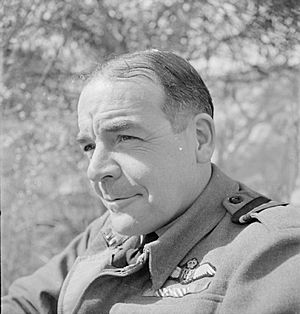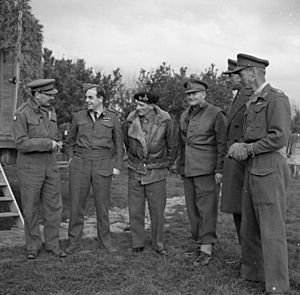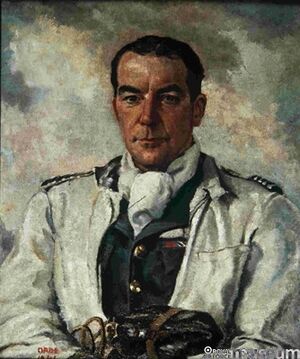Harry Broadhurst facts for kids
Quick facts for kids
Sir Harry Broadhurst
|
|
|---|---|

Harry Broadhurst, pictured here while Air Officer Commanding, Western Desert Air Force.
|
|
| Nickname(s) | "Broady" |
| Born | 28 October 1905 Frimley, Surrey, England |
| Died | 29 August 1995 (aged 89) Birdham, Chichester District, West Sussex, England |
| Allegiance | United Kingdom |
| Service/ |
Royal Air Force |
| Years of service | 1925–1961 |
| Rank | Air Chief Marshal |
| Service number | 24035 |
| Commands held | Allied Air Forces Central Europe (1959–61) Bomber Command (1956–59) Second Tactical Air Force (1953–56) No. 61 Group (1946–48) No. 83 Group (1944–45) Desert Air Force (1943–44) RAF Hornchurch (1941–42) RAF Wittering (1940) RAF Coltishall (1940) No. 111 Squadron (1939–40) |
| Battles/wars | Second World War |
| Awards | Knight Grand Cross of the Order of the Bath Knight Commander of the Order of the British Empire Distinguished Service Order & Bar Distinguished Flying Cross & Bar Air Force Cross Mentioned in Despatches (3) Officer of the Legion of Merit (United States) Grand Officer of the Order of Orange-Nassau (Netherlands) |
Sir Harry Broadhurst, also known as "Broady," was a very important leader in the Royal Air Force (RAF). He was also a flying ace during the Second World War, meaning he shot down many enemy planes. He was born on October 28, 1905, and passed away on August 29, 1995.
Contents
Joining the RAF
Harry Broadhurst was born in 1905 in Frimley, England. He first joined the British Army as a young officer in the Royal Artillery. In 1926, he decided to switch and joined the Royal Air Force (RAF).
Becoming a Skilled Pilot
After finishing his training, Broadhurst joined No. 11 Squadron RAF in India in 1928. He flew planes like the Westland Wapiti and Hawker Hart over the North West frontier. He returned to the United Kingdom in 1931 and joined No. 41 Squadron RAF, flying the Bristol Bulldog.
By the mid-1930s, Broadhurst was known as an amazing pilot. He flew fighter planes and performed daring stunts at air shows. People saw him as an aerial daredevil because of his exciting aerobatics. In 1936, the king himself, Edward VIII, congratulated him on his amazing flying in the Gloster Gauntlet.
In 1937, he received the Air Force Cross for his bravery. He then attended the RAF Staff College in Andover. In January 1939, he became the leader of No. 111 Squadron RAF.
World War II Heroics
In May 1940, Broadhurst became the Station Commander at RAF Coltishall. He then joined No. 60 Wing in France as a wing commander. He helped support ground troops during the Battle of France. This experience taught him how important it was for planes to work closely with soldiers on the ground.
He played a big part in the Battle of Britain. As the leader of RAF Wittering, he often flew with the squadrons under his command. He flew both day and night missions. In December 1940, he was put in charge of the Hornchurch Sector of No. 11 Group Fighter Command. Even as a group captain, he continued to fly in combat.
Flying Ace in Action
On July 4, 1941, Broadhurst led No. 54 Squadron. He got into a dogfight with German Bf 109s. He shot down two Bf 109s over Béthune. His own plane was badly damaged, but he managed to land it safely back at base.
On July 7, 1941, his Spitfire was again severely damaged by a German pilot. He still managed to shoot down another Bf 109. By August 1942, he had shot down 13 enemy planes, with seven more probably destroyed and 10 damaged.

In late 1942, he moved to the Middle East. He became a senior officer for the Desert Air Force (DAF). In January 1943, Broadhurst took command of the DAF. At 38 years old, he became one of the youngest air vice marshals in the RAF.
He quickly improved how fighter planes were used to support ground troops. His squadrons trained hard to attack German and Italian vehicles, tanks, and supply lines. This air support for the 8th Army was highly praised by General Bernard Montgomery. These tactics later became key for the D-Day landings and other operations.
Broadhurst's strong support for the Army and his honest opinions sometimes caused disagreements with his RAF superiors. In 1944, he returned to the UK to lead No. 83 Group. In September 1945, he became the Air Officer Administration at RAF Fighter Command.
After the War
In August 1946, Broadhurst was made Air Officer Commanding No. 61 Group. In 1949, he attended the Imperial Defence College. After being promoted to air vice marshal again in July 1949, he became Assistant Chief of the Air Staff (Operations) in April 1952. Then, in December 1953, he became Commander-in-Chief of Second Tactical Air Force as an air marshal.
Leading Bomber Command
Broadhurst was appointed Air Officer Commander-in-Chief of Bomber Command in January 1956. During this time, an Avro Vulcan aircraft he was on had an accident. Broadhurst was on a round-the-world tour with the first Vulcan delivered to the RAF.
On their return to the UK, they were to land at London Heathrow Airport. The weather was bad, and RAF aircraft were not set up for the landing system used at civil airports. The plane hit the ground before the runway. Broadhurst and the pilot ejected safely, but four other crew members died.
An investigation found that the ground control instructions and the plane's fast descent contributed to the accident. This event led to improvements in aircraft landing systems, making them safer. The Vulcan later became one of the first planes able to land automatically.
Broadhurst was promoted to Air Chief Marshal in February 1957. In 1959, he became Commander of Allied Air Forces Central Europe. He retired from the RAF in March 1961.
Later Career
After retiring from the RAF, Broadhurst became the managing director of Avro Aircraft. In 1965, he became the managing director of Hawker Siddeley Aviation Ltd. In 1968, he became a Director of the Hawker Siddeley Group Limited, retiring in 1976.


